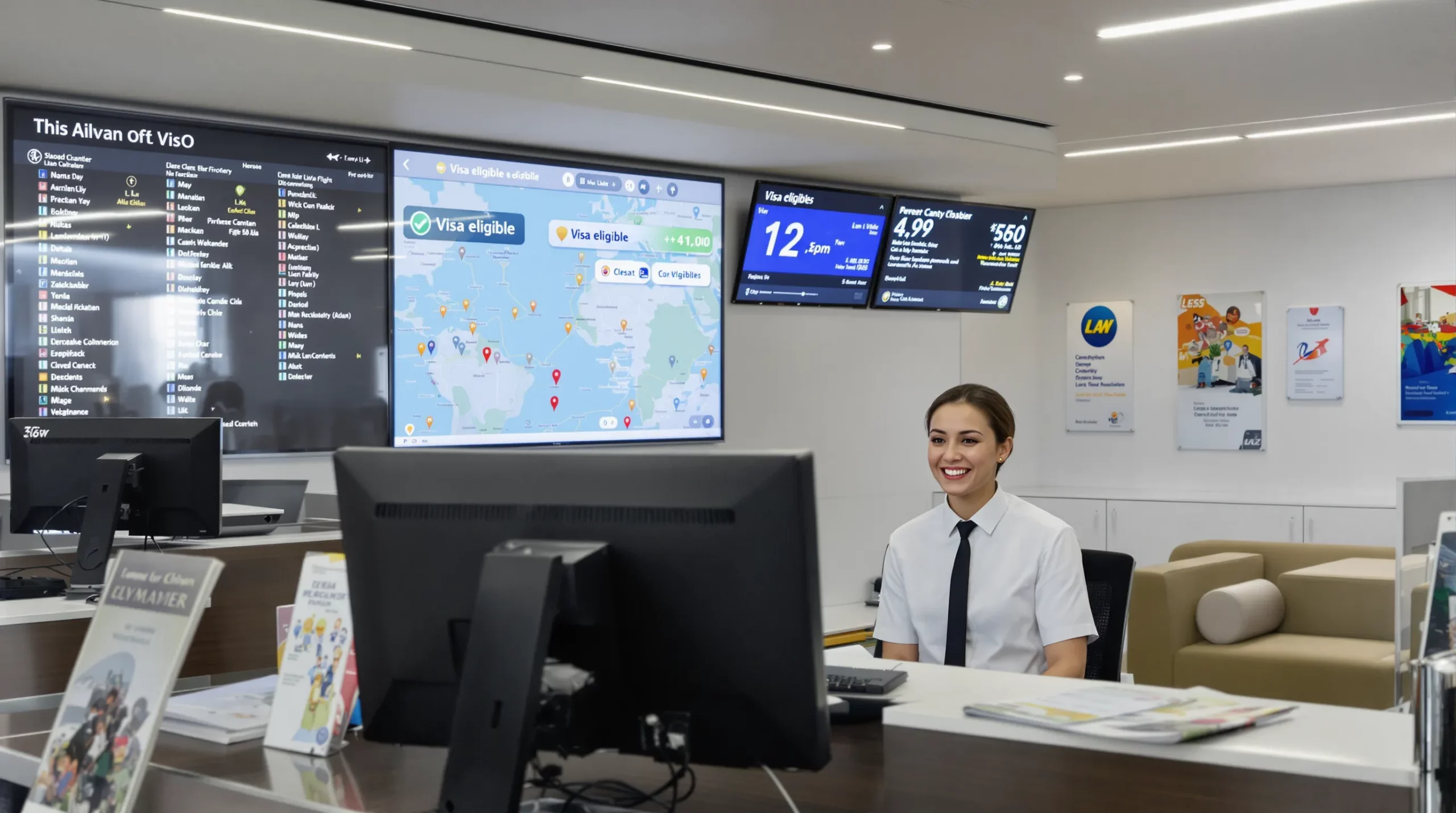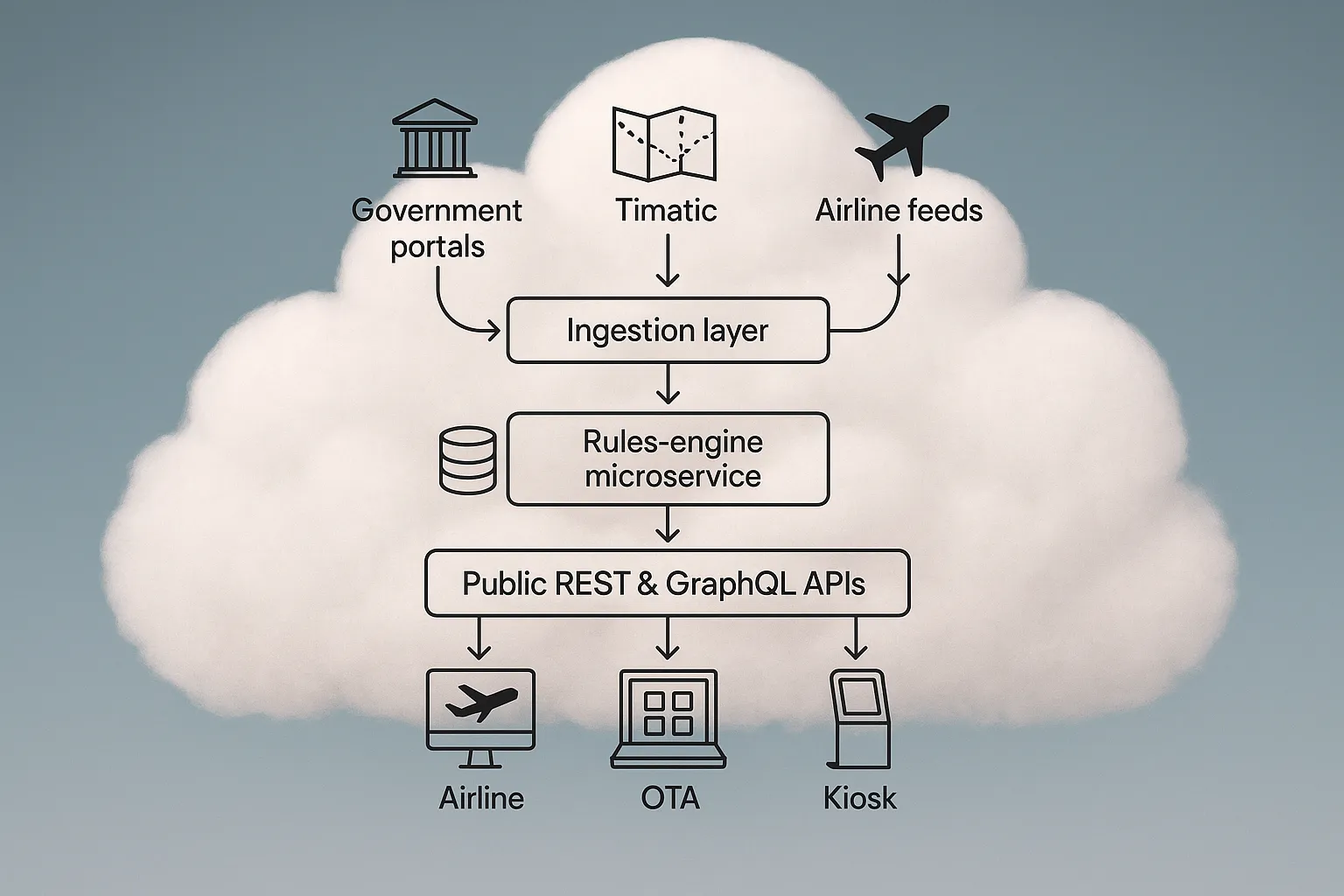Real-Time Visa Eligibility Checks: Architecture & Implementation Tips

Why “real-time” matters for visa eligibility
Every day, governments push dozens of regulatory updates to their immigration systems. In 2024 alone the IATA Timatic database logged more than 70,000 changes to entry rules, vaccination requirements and visa fee schedules. For an airline, OTA or TMC, serving yesterday’s rules risks denied boarding fines that routinely exceed $3,500 per passenger.
Real-time visa eligibility checks bridge this gap. By querying the latest border-control data at the moment of booking—or even at online check-in—you can:
- Prevent costly re-work at the airport desk
- Increase conversion by showing clear “You’re good to go” messages
- Cross-sell eVisas and other travel extras inside the flow
The challenge: building a solution that is fast, reliable and compliant. Below we dissect a modern architecture for real-time visa eligibility and share implementation tips drawn from 400+ SimpleVisa integrations.
The reference architecture

-
Data ingestion connectors
- Scrapers or webhook listeners pull updates from consular sites, ICAO, WHO and Timatic.
- A CDC (Change Data Capture) pattern streams deltas into Kafka topics.
-
Normalization layer
- Transforms heterogeneous data into a common JSON schema (ISO 3166 country codes, ISO 8601 dates, IATA document types).
- Flags conflicting rules for manual review.
-
Rules engine microservice
- State-machine model evaluates nationality, residency, travel history, vaccination records, purpose of trip and length of stay against policy rules.
- Supports A/B override so policy analysts can hot-fix logic without redeploying code.
-
Low-latency eligibility cache
- Redis or DynamoDB configured with TTL < 1 hour.
- Response keys hashed on passport country + destination + trip dates to hit > 95 % cache ratio.
-
Public API gateway
- REST / GraphQL endpoints secured by OAuth 2.0 client credentials.
- Average p95 response time < 250 ms even at 1,000 req/s.
-
Event bus for proactive alerts
- Publishes
visa.status.changedevents when an itinerary becomes non-compliant after booking. - Subscribers (CRM, email, push) trigger passenger notifications.
- Publishes
-
Observability & compliance
- Distributed traces (OpenTelemetry) feed into Grafana dashboards.
- PII encrypted in transit and at rest; platform aligns with ISO 27001 and PCI-DSS.
Build vs buy: evaluating your options
| Factor | Roll-your-own solution | Plug-in API platform (e.g., SimpleVisa) |
|---|---|---|
| Data licensing | Must contract Timatic, consular RSS etc. individually | Covered in subscription |
| Engineering headcount | 4–6 FTEs Dev + QA + SRE | 0–1 FTE for integration |
| Time to market | 9–12 months | 3–6 weeks |
| Ongoing maintenance | 24/7 ops and policy analysts | Handled by provider |
| Ancillary revenue tools | Build from scratch | Built-in upsell flows |
Unless visa revenue already exceeds mid-seven figures annually, most travel brands find better ROI with a specialised API. That said, understanding the underlying architecture helps you integrate smartly and avoid vendor lock-in.
Implementation tips that save weeks of dev time
1. Decide where in the journey to surface checks
- Search results page: Display a badge (“Visa required”) beside each destination. Needs ultra-fast TTL cache.
- Traveller details step: After the user enters nationality, call the eligibility API to show exact requirements and sell eVisas.
- Pre-departure email: Subscribe to change events so you can alert passengers automatically when rules shift (think ETIAS go-live Q2 2025).
Mixing these touchpoints maximises conversion while keeping compute costs under control.
2. Pass the right minimum dataset
A surprising number of failed calls stem from missing fields. At SimpleVisa, the following 5 attributes cover 92 % of eligibility logic:
{
"nationality": "CAN",
"passportIssuedBy": "CAN",
"destination": "THA",
"departureDate": "2025-11-10",
"returnDate": "2025-11-24"
}
Add optional parameters like residencyCountry, previousVisaRefusals or vaccinationCertificates only for advanced use cases (work permits, long stays).
3. Cache wisely—not blindly
A blanket 24-hour cache might look fine until Thailand updates yellow-fever rules at midnight GMT and your EU customers wake up to stale results. Best practice:
- Short TTL (15–60 min) for countries with high change velocity (South-East Asia, Sub-Saharan Africa).
- Longer TTL (6–12 h) for low-volatility destinations (Schengen, US, Canada).
- Use ETags so the server tells you when nothing changed; saves bandwidth.
4. Fail open vs fail closed
If the eligibility endpoint times out, do you block the booking? Airlines often fail open to preserve revenue, tagging the PNR for manual review. Cruise lines, with longer lead times, prefer fail closed to avoid visa-denied boarding at embarkation. Define the rule early and wire it into your error-handling middleware.
5. Design for rule explainability
Regulators increasingly demand transparency in automated decision making. Ask your provider for a decisionTree object that explains why a traveller is (in)eligible. Exposing that rationale reduces call-center load and builds passenger trust.
{
"eligible": false,
"decisionTree": [
{
"rule": "Thailand tourist stay >30 days",
"result": "failed",
"details": "Stay length 35 > limit 30"
},
{
"rule": "Passport validity 6+ months",
"result": "passed"
}
],
"nextStep": "Apply for 60-day eVisa"
}
6. Secure the pipeline end-to-end
- Enforce mTLS between your backend and the visa eligibility API to prevent man-in-the-middle attacks.
- Rotate client secrets every 90 days; automate via AWS Secrets Manager or HashiCorp Vault.
- Log access tokens with trace IDs, never with full passport numbers.
7. Consider GDPR and CCPA early
Visa eligibility requires sensitive personal data. Under GDPR, travel companies act as data controllers. Make sure your DPA (Data Processing Agreement) covers:
- Lawful basis (contractual necessity)
- Data retention (delete after trip completion + 30 days)
- Sub-processor transparency
SimpleVisa maintains an up-to-date trust center with audit reports to simplify vendor assessments.
Case study: OTA increases conversion by 7 %

TravelHype, a mid-size European OTA, integrated SimpleVisa’s eligibility endpoint directly into their React checkout component.
- Implementation time: 24 engineering days
- Cache hit rate: 93 %
- Booking abandonment drop: 7 % relative
- Ancillary visa revenue: +€3.2 M in first 12 months
Key takeaway: Even modest UX tweaks (swapping a generic tooltip for a real-time eligibility banner) can boost both top-line and customer satisfaction.
Frequently Asked Questions (FAQ)
How is real-time data different from daily batch updates? A real-time feed ingests rule changes within minutes, ensuring the advice customers see at 9 am matches border policy announced at 8:45 am. Batch files can leave a 12- to 24-hour blind spot.
Does an eligibility check guarantee visa approval? No. It confirms whether the traveller should be able to enter under current rules. Final approval remains with the destination’s immigration authority, though automated eVisa issuance rates exceed 95 %.
What happens when rules change after booking? If you subscribe to visa.status.changed events, you can notify passengers automatically and, when relevant, upsell the new required eVisa in one click.
Can I integrate the API without writing code? Yes. SimpleVisa offers a no-code widget and white-label app that you can embed via an iframe or deep link.
How much latency should I expect? Typical p95 latency is under 250 ms over public internet. For ultra-low latency use cases (airport kiosks), ask for SimpleVisa’s regional edge proxies.
Ready to put visa anxiety on autopilot?
Whether you run an airline website, a cruise booking engine or a corporate OBT, real-time visa eligibility is now table stakes. Schedule a 20-minute demo with SimpleVisa’s solution architects to see how fast you can go live—and start turning compliance headaches into ancillary revenue.